The objective of digital and ICT strategic planning is to provide a future vision and plan for how the services of an agency will be transformed using digital technology. To do this it is necessary for practitioners to understand the current state of an organisation’s significant services and related business processes that are within the scope of the planning engagement.
A practitioner in the context of this guideline can include one or more of the following roles:
- Digital and ICT strategic planners
- Agency and service strategic planners
- Enterprise architects
- Business analysts.
The activities in this guideline provide practitioners with an understanding of the current services and business process of the agency or business area. It also highlights the significance of services and business processes with regard to their contribution to achieving the organisation’s strategic objectives or business imperatives.



